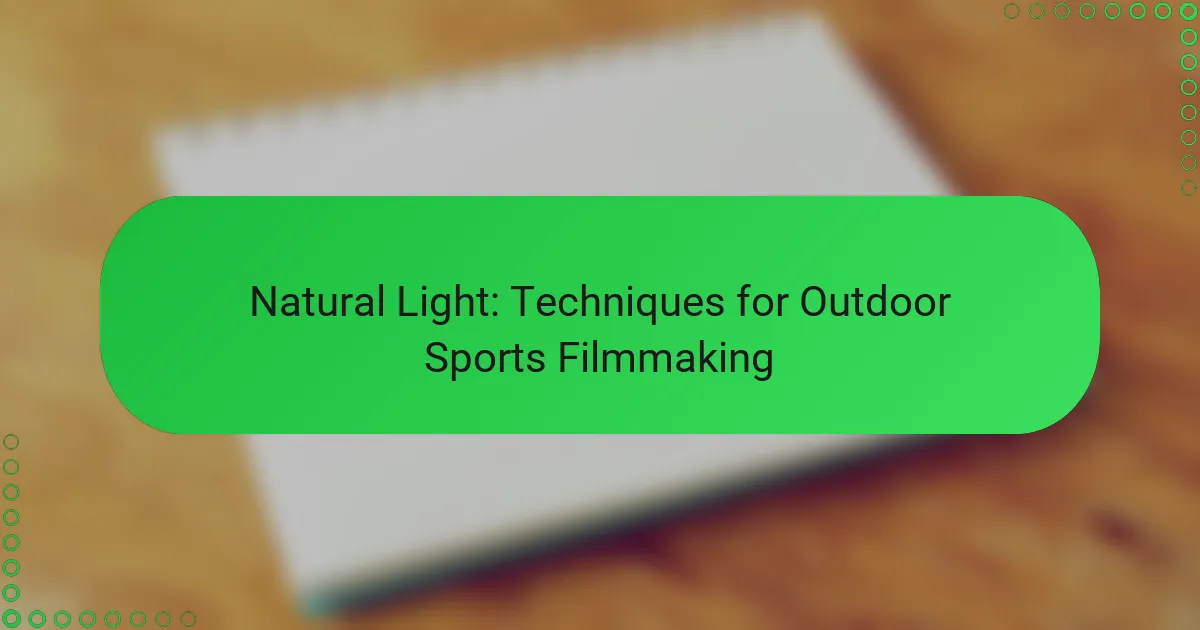Natural light plays a vital role in outdoor sports filmmaking, enhancing the visual quality and emotional impact of your footage. By mastering techniques that optimize light direction and timing, particularly during the golden hours of early morning and late afternoon, filmmakers can achieve stunning results. Essential equipment, including the right camera and stabilization tools, further supports the effective capture of dynamic action in natural settings.

What Techniques Enhance Natural Light for Outdoor Sports Filmmaking?
To enhance natural light in outdoor sports filmmaking, consider techniques that optimize the quality and direction of light. Effective use of timing, tools, and creative approaches can significantly elevate the visual impact of your footage.
Golden hour shooting
Shooting during the golden hour, which occurs shortly after sunrise and before sunset, provides soft, warm lighting that flatters subjects. The angle of the sun during this time creates long shadows and a beautiful glow, enhancing the overall aesthetic of outdoor sports scenes.
Plan your shoots around these times to capture the best natural light. A good rule of thumb is to arrive at your location at least 30 minutes before sunrise or sunset to set up and prepare for the optimal lighting conditions.
Using reflectors
Reflectors can redirect sunlight to illuminate your subjects more evenly, reducing harsh shadows and enhancing details. They come in various materials and colors, such as silver for a bright bounce or gold for a warmer tone.
When using reflectors, position them at an angle to maximize light on your subject’s face or body. This technique is especially useful during midday when the sun is high and creates unflattering shadows.
Diffusing sunlight
Diffusing sunlight softens harsh light and minimizes glare, making it ideal for capturing dynamic sports action. You can use materials like silk or specialized diffusion fabrics to create a softer light source.
Set up a diffusion panel between the sun and your subject to achieve a more even light distribution. This technique works well in various outdoor settings, ensuring that your footage remains visually appealing without overexposed highlights.
Backlighting subjects
Backlighting involves positioning the light source behind your subject, creating a dramatic silhouette effect. This technique can add depth and interest to your shots, particularly during sunrise or sunset.
To avoid losing detail in the shadows, use a fill light or reflector to illuminate the subject’s features. This approach can enhance the emotional impact of your footage, making it more engaging for viewers.
Using shadows creatively
Shadows can be powerful tools in outdoor sports filmmaking, adding depth and contrast to your shots. Experiment with different angles and positions to create interesting shadow patterns that complement the action.
Consider the time of day and the sun’s position when planning your shots. Using shadows effectively can highlight movement and create a more dynamic visual narrative, enhancing the storytelling aspect of your film.

How to Choose the Right Time of Day for Filming?
Choosing the right time of day for outdoor sports filmmaking is crucial for capturing optimal natural light. Early morning and late afternoon, often referred to as the golden hours, provide soft, warm lighting that enhances the visual appeal of your footage.
Understanding light angles
Light angles significantly affect how subjects are illuminated and how shadows are cast. During the golden hours, the sun is low in the sky, creating long shadows and a flattering light that can add depth to your shots. As the sun rises higher, the light becomes harsher, which can lead to unflattering contrasts and overexposed highlights.
To maximize the impact of light angles, consider the direction of the sun relative to your subject. Shooting with the sun behind you can illuminate your subject evenly, while shooting against the sun can create dramatic silhouettes.
Weather conditions impact
Weather conditions play a vital role in outdoor filming, as they can drastically alter light quality. Overcast days provide diffused light, which is ideal for reducing harsh shadows and creating a soft, even look. However, bright sunny days can produce strong contrasts that may require careful exposure management.
Always check the weather forecast before planning your shoot. If conditions are not favorable, consider rescheduling or adjusting your shooting techniques, such as using reflectors or diffusers to manage light effectively.
Seasonal variations
Seasonal variations can influence the quality and duration of natural light available for filming. In summer, longer daylight hours provide more opportunities to shoot during optimal light conditions, while winter days are shorter and may require more precise planning.
Additionally, the angle of the sun changes with the seasons, affecting how light interacts with your subjects. For instance, in winter, the sun is lower in the sky, which can create unique lighting effects that differ from summer shoots. Plan your shoots according to the season to take advantage of these variations.

What Equipment is Essential for Natural Light Filmmaking?
Essential equipment for natural light filmmaking includes a suitable camera, lenses, and stabilization tools. These elements work together to capture high-quality footage in outdoor sports settings, maximizing the available light and ensuring smooth motion.
Camera types for outdoor sports
For outdoor sports filmmaking, mirrorless and DSLR cameras are popular choices due to their versatility and image quality. Look for models that perform well in varying light conditions and offer fast autofocus to keep up with moving subjects.
Consider cameras with weather-sealing features if filming in unpredictable outdoor environments. Models from brands like Canon, Sony, and Nikon often provide robust options for sports videography.
Lens recommendations
Choosing the right lens is crucial for capturing dynamic outdoor sports. A fast zoom lens, such as a 24-70mm f/2.8, allows for flexibility in framing while maintaining good low-light performance. Prime lenses, like a 50mm f/1.8, can also be effective for shallow depth of field and sharp images.
Wide-angle lenses (e.g., 16-35mm) are beneficial for capturing expansive scenes or close action shots, while telephoto lenses (e.g., 70-200mm) help isolate subjects from a distance. Ensure your lens has good optical stabilization to reduce shake during movement.
Tripods and stabilizers
Using a sturdy tripod is essential for stable shots, especially in windy conditions. Look for lightweight tripods that are easy to transport and can handle the weight of your camera setup. A fluid head tripod can provide smooth panning for action shots.
For more dynamic filming, consider handheld gimbals or steadicams, which help eliminate unwanted camera shake while allowing for fluid movement. These tools are particularly useful when following athletes in motion or capturing fast-paced scenes.

How to Plan Shots for Optimal Natural Lighting?
To plan shots for optimal natural lighting, consider the time of day, weather conditions, and the location of your shoot. Early morning and late afternoon, known as the golden hours, provide the best light for outdoor sports filmmaking, enhancing colors and reducing harsh shadows.
Creating a shot list
A well-structured shot list is essential for capturing the best natural light. Start by identifying key scenes and angles that highlight the action and environment. Prioritize shots that utilize the sun’s position to create dynamic visuals, such as backlighting or side lighting.
Include specific details in your shot list, such as the desired time of day for each shot and any necessary equipment. This preparation helps streamline the filming process and ensures you make the most of the available light.
Storyboarding techniques
Storyboarding is a valuable technique for visualizing how natural light will impact your shots. Create sketches or digital frames that outline the composition, camera angles, and lighting conditions for each scene. This visual guide helps anticipate how light will change throughout the day.
Consider using software or apps designed for storyboarding to easily adjust and rearrange scenes as needed. This flexibility allows you to adapt to changing light conditions or unexpected weather, ensuring your final film remains cohesive and visually appealing.

What Are Common Challenges in Natural Light Filmmaking?
Natural light filmmaking presents challenges such as harsh sunlight and rapidly changing light conditions. These factors can affect the quality of outdoor sports footage, making it essential to understand how to manage them effectively.
Dealing with harsh sunlight
Harsh sunlight can create strong shadows and overexposed highlights, which detract from the visual quality of your footage. To mitigate this, consider shooting during the golden hours—shortly after sunrise or before sunset—when the light is softer and more flattering.
Using reflectors or diffusers can help control harsh light by softening shadows and reducing glare. Additionally, adjusting your camera settings, such as lowering ISO or using ND filters, can help manage exposure levels in bright conditions.
Managing changing light conditions
Outdoor sports often involve dynamic environments where lighting can shift quickly due to weather changes or time of day. To adapt, keep your camera settings flexible, allowing for quick adjustments to aperture, shutter speed, and ISO as conditions change.
Using manual focus can also help maintain clarity as light fluctuates. It’s beneficial to scout locations beforehand to identify potential light sources and plan your shots accordingly, ensuring you can capture the action effectively despite varying light.

What Are the Best Practices for Editing Natural Light Footage?
Editing natural light footage requires careful attention to color balance and exposure to enhance the visual quality. Key practices include color grading, adjusting contrast, and ensuring consistency across shots to maintain a cohesive look.
Color grading techniques
Color grading is essential for enhancing the mood and atmosphere of outdoor sports footage captured in natural light. Techniques such as adjusting the hue, saturation, and luminance can significantly impact how the footage feels. For instance, warmer tones can evoke a sense of energy, while cooler tones might create a more relaxed vibe.
When color grading, consider using software tools that allow for precise adjustments. Popular options include Adobe Premiere Pro and DaVinci Resolve, which offer advanced features for manipulating color. Aim for a balanced look by ensuring that skin tones appear natural and that the colors of the environment are true to life.
Common pitfalls include over-saturation or excessive contrast, which can lead to unnatural visuals. A good practice is to create a reference grade that can be applied across similar shots to maintain consistency. Always preview your edits on different screens to ensure the colors translate well across various devices.
